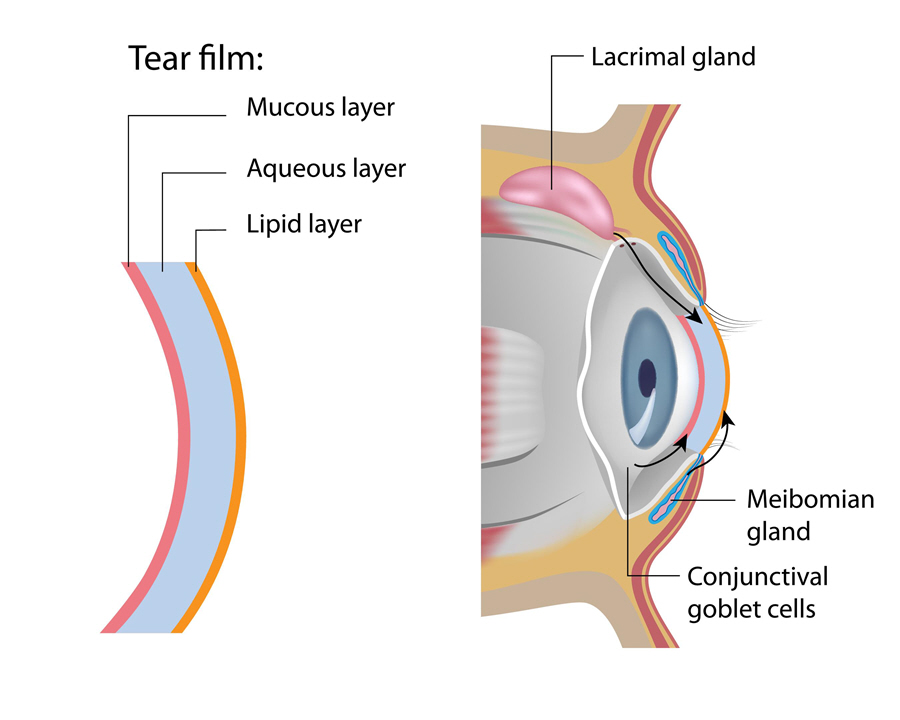Introduction
When a person blinks, a film of tears spread over the eye. They make the eye surface bright and smooth and vision possible and sharp. A variety of sources on the eye’s surface secrete the tear film. It is a complex mixture of material from the goblet cells, the lacrimal glands and the meibomian glands.
Anatomy
The tear film is composed of three parts:
- An oily (lipid) outer layer
- An aqueous (watery) middle layer
- A mucus (mucin) inner layer
Function
Tears play a critical role in the health of the eyes and in vision. They form a protective coating over the eye surface. If one doesn’t blink often enough, dry spots may develop on the eye surface reducing vision. The tear film serves four vital purposes:
- Lubricates and protects the eyes
- Clears debris and foreign particles
- Minimizes the risk of eye infection
- Maintains a smooth and clear eye surface
To this end, each layer has its function:
The meibomian glands produce the oily layer whose primary role is to seal the tear film. It reduces evaporation of tears and makes the tear surface smooth.
The lacrimal glands produce the middle aqueous layer. It serves to lubricate the eye, cleanse the eyes, clear irritants and foreign particles and prevent infection.
The conjunctiva produces the mucus layer. It allows the watery layer to spread well over the eye surface. The mucus layer aids the eye in maintaining moisture and lubrication and nourishes the underlying cornea. It also enables tears to stick to the eye.
Associated symptoms & disorders
Tear film disorders may occur due to:
Poor quality of tears – It happens when there is an imbalance in the tear composition. The meibomian glands might become clogged or dysfunctional. There may be a lacrimal glands disorder or goblet cell deficiency/mucin deficiency.
Increased tear evaporation –It is where tears evaporate too fast or do not spread well over the cornea because of problems with any of the three layers of tears.
Inadequate amount of tears - Tear production may decrease because of age, various medical conditions, certain medicines, eye surgery or environmental conditions.
Dry eye syndrome is also referred to as tear film dysfunction or dysfunctional tear syndrome (DTS). It is a common eye condition that occurs because of inadequate lubrication. Dry eye may cause damage to the eye surface, eye infections and decreased quality of life.
Diagnosis of associated disorders
The eye care professional can diagnose tear film dysfunction by a comprehensive eye examination that includes the patient’s complete medical history and eye health. The professional checks the volume and quality of the tears and the tests may include:
- Sjo test
- Meibometry
- Schirmer test
- Tear osmolarity
- Eye surface staining
- Delayed tear clearance
- Tear film interferometry
- Tear break up time (TBUT)
- Tear meniscus height (meniscometry)
He/she may also examine the face and eyelids, eyelid margins, eyelashes, blinking patterns, conjunctiva and cornea.
Treatment of associated disorders
The eye doctor may prescribe medication including:
Tear-stimulating pills, gel or eye drops.
Antibiotics to reduce eyelid inflammation. The medicines may be in the form of tablets, ointments or eye drops.
Immune-suppressing medication corticosteroids or cyclosporine (restasis). These are eye drops that treat cornea inflammation.
Eye inserts that work like artificial tears. Artificial tears may not be useful for patients with moderate to severe dry eye symptoms. The doctor may recommend Lacrisert (hydroxypropyl cellulose) inserts. They are little eye inserts that work as lubricants.
Autologous blood serum drops –These are eye drops made from the patient’s blood. They may be an option where a patient has severe dry eye symptoms and no other treatment option is useful.
The eye surgeon may also recommend closing the tear ducts to reduce tear loss. He/she uses tiny removable silicone plugs to seal the tubes. The surgeon could also use thermal cautery, a procedure that utilizes heat to plug the ducts.
A thermal pulsation device can unblock the oil glands. Eye masks or warm compresses used daily may also help clear up blocked oil glands. Intense-pulsed light therapy coupled with eyelids massage can be helpful to patients with severe dry eyes.


